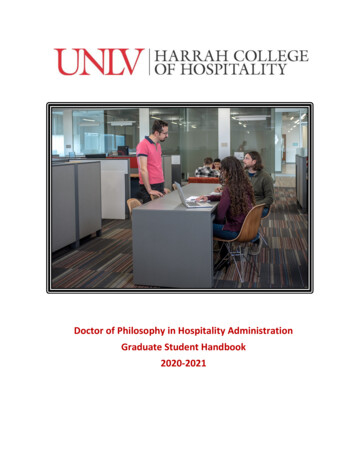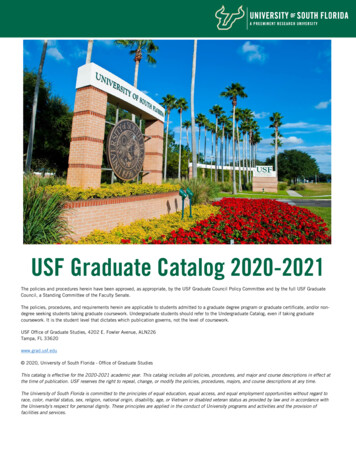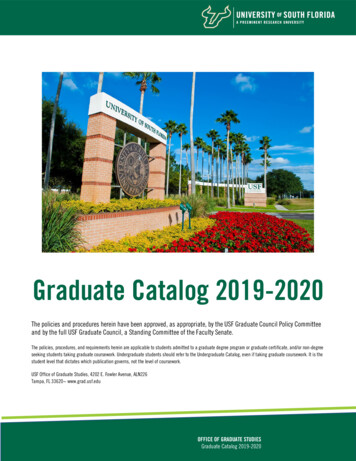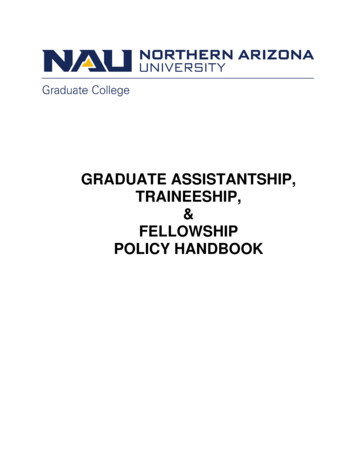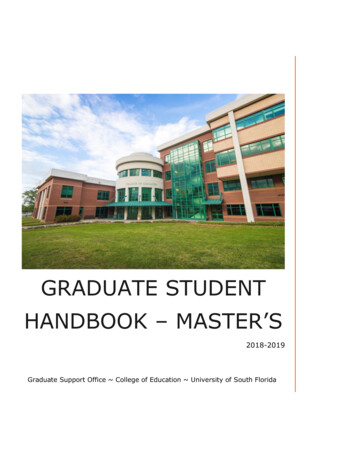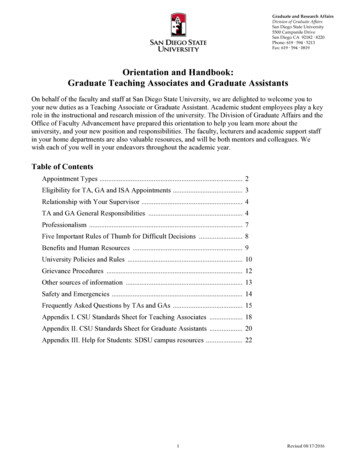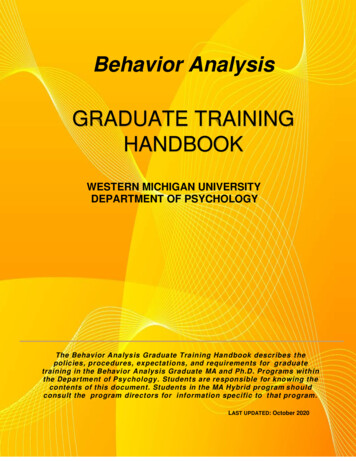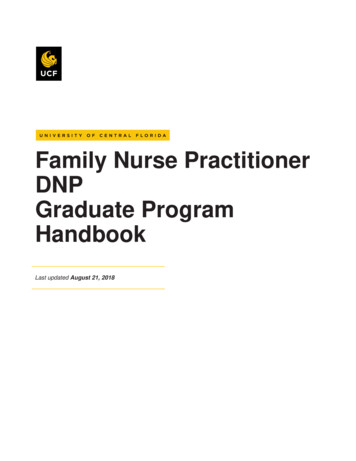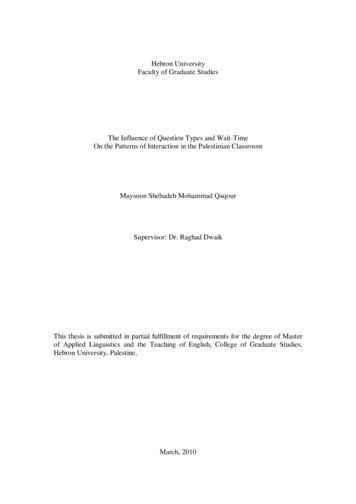
Transcription
Hebron UniversityFaculty of Graduate StudiesThe Influence of Question Types and Wait-TimeOn the Patterns of Interaction in the Palestinian ClassroomMaysoon Shehadeh Mohammad QaqourSupervisor: Dr. Raghad DwaikThis thesis is submitted in partial fulfillment of requirements for the degree of Masterof Applied Linguistics and the Teaching of English, College of Graduate Studies,Hebron University, Palestine.March, 2010
Classroom interaction2
Classroom interactionDedicationTo my mother and to the soul of my fatherI
Classroom interactionAcknowledgementLoads of thanks are solely extended to my supervisor Dr. RaghadDwaik whose efforts led to the success of this work. She guided me andhelped me in every detail providing me with her advice and Patience. Shewas generous with her support of references and any kind of material shefound.I also would like to thank Dr. Sameer Rammal, the externalexaminer; Dr. Hanna Tusheiyeh, the internal Examiner, and Dr. RadwanBarakat, Dean of Graduate Studies.I would like to extend more thanks to the teachers who helped me toconduct this study and were cooperative and patient.Piles of thanks and gratitude are truly extended to my husband forhis constant support and patience. He provided me with strength andenhanced my confidence and faith in the job I'm carrying out. I cannotforget my kids who paid the ultimate price. They used to waiting me allday to throw themselves among my arms and they were full of patience inexams times.II
Classroom ementContentsList of appendicesList of tablesAbstractChapter oneIntroductionTheoretical frameworkStatement of the problemSignificance of the studyPurpose of the studyResearch questionsLimitations of the studyDefinition of key termsChapter twoLiterature ReviewIIIIIIVVI1777991011121315Question Types' Treatment in classroomresearchesWait- Time treatment in classroom researchThe relation between Question types andother affective factors/modificationsClassroom Research: developments andStudiesDevelopments in Language ClassroomResearchConclusionChapter threeMethodologyIntroductionPopulation and sampleResearch designInstrumentationClassroom observationProceduresStage oneStage two/ phase oneStage two/ phase twoValidation of the questions whichwere asked in the classroomInterviews and interview questionsValidation of the interviews andIII151619242526282828293131323233343435
Classroom interactionthe questions of the interviewsThe sample of the interviewsValidation of the questions of theInterviewsConclusionChapter fourResultsClassroom observationStage oneStage two / phase oneStage two / phase twoResults of the interviewsConclusionChapter fiveDiscussionIntroductionWait-timeQuestion typesPatterns of interactionDiscussion of interviews' 7780105
Classroom interactionList of appendicesAppendix AAppendix BAppendix CAppendix DAppendix Einterview questionsInterviewsData Collection sheetsReading TextsList of Referential QuestionsV80819195104
Classroom interactionList of tablesTable 3.1Distribution of students' sample by stream and gender29Table 1.1A descriptive analysis of question types, wait-time and numberOf participants pertaining to stage one/ day one38Table 1.2A descriptive analysis of question types, wait-time and numberOf participants pertaining to stage one/ day two40Table 1.3A descriptive analysis of question types, wait-time and numberOf participants pertaining to stage one/ day three41Table 1.4A descriptive analysis of question types, wait-time and numberOf participants pertaining to stage one/ day four42Table 1.5A descriptive analysis of question types, wait-time and numberOf participants pertaining to stage one/ day five44Table 1.6A descriptive analysis of question types, wait-time and numberOf participants pertaining to stage one/ day six45Table 2.1A descriptive analysis of question types, wait-time and numberOf participants pertaining to stage two/ phase one/ day one 46Table 2.2A descriptive analysis of question types, wait-time and numberOf participants pertaining to stage two/ phase one/day two 47Table 2.3A descriptive analysis of question types, wait-time and numberOf participants pertaining to stage two/ phase one/ day three48Table 2.4A descriptive analysis of question types, wait-time and numberOf participants pertaining to stage two/ phase one/ day four 49Table 2.5A descriptive analysis of question types, wait-timeand number Of participants pertaining to stage two/ phase one/ day five50Table 3.1A descriptive analysis of question types, wait-time and numberOf participants pertaining to stage two/ phase two/ day one 51Table 3.2A descriptive analysis of question types, wait-time and numberOf participants pertaining to stage two/ phase two/ day two 53Table 3.3A descriptive analysis of question types, wait-time and numberOf participants pertaining to stage two/ phase two/ day three54Table 3.4A descriptive analysis of question types, wait-time and numberVI
Classroom interactionTable 3.5Table 3.6Table 1Of participants pertaining to stage two/ phase two/ day four 55A descriptive analysis of question types, wait-time and numberOf participants pertaining to stage two/ phase two/ day five 55A descriptive analysis of question types, wait-time and numberOf participants pertaining to stage two/ phase two/ day six 56A summary table shows the percentage of participation,total number of display and referential questions in stages one and two. 57Table 4.1.aA summary table for stage one62Table 4.1.bA summary table for stage two/ phase one64Table 4.2.aA summary table for stage two/ phase two69Table 4.2.bPercentage of participation69Table 4.2.cDifference in participation between males and females71VII
Classroom interactionAbstractDespite the adoption of the Communicative Approach in the Palestinian syllabusfor the purpose of building the learners' communicative competence, most Englishteachers notice that Palestinian English learners hesitate to take part in classroominteraction probably due to their lack of proficiency in language use.This seriousphenomenon could be due to several factors including the dense curriculum which, inturn, constitutes a heavy burden for students and teachers, the low proficiency of someteachers as well as the neglect of some teaching strategies (e.g.failing to varyquestion types or to provide enough wait-time, confining students to a passive roleand using vague or complex language, etc).Many researchers and writers such as Chaudron (1990) and Celce-Murcia(2001) have provided a thorough literature review of all issues and factors tackled inclassroom research and in other types of related research. The researcher has drawnon the wealth of research evidence provided by these authors, hence deciding to shedmore light on issues related to the Palestinian classroom such as the Variables:Question types and Wait-time.The researcher believes that these two variables are decisive in determining thequantity and quality of the classroom interaction that takes place in the Palestiniancontext. In turn, this resulting interaction is essential in providing the input necessaryfor building the students' communicative competence through the processes ofhypothesis formation and testing, the very goal of the communicative approach. Forthis purpose, a qualitative classroom research study was conducted to explore theextent to which teachers maintain a proper duration of wait-time and raise appropriate1
Classroom interactionquestion types in two secondary schools in the area of Se'ir (one for girls and one forboys).The sample of the study may be divided into two categories: the first categoryincludes ten high school English teachers who were interviewed. The secondcategory, includes 263 eleventh Grade students- 101 boys and 162 girls- who wereenrolled in eight separate sections both in the literary and scientific streams dividedrandomly as 3 scientific sections and 5 literary sections- enrolled in the academic year2008-2009 in two schools in the town of Se'ir.This study aims at finding answers for a set of questions pertaining to both stages ofthe research, i.e., the observation and the intervention stages; as well as for the followup interviews.Research QuestionsObservation stage: How long do teachers of the Eleventh Grade Scientific stream (Girls' and Boys'school teachers) usually wait after asking a question? How long do teachers of the Eleventh Grade Literary stream (Girls' and Boys'school teachers) usually wait after asking a question? What types of questions prevail in the Eleventh Grade Scientific stream (Girlsand Boys), referential or display? What types of questions prevail in the Eleventh Grade Literary stream (Girls andBoys), referential or display?Intervention stage: What influence does extending the wait-time have on the quantity and quality ofinteraction among students in the eleventh grade scientific stream (Girls andBoys)?2
Classroom interaction What influence does extending the wait-time have on the quantity and quality ofinteraction among students in the eleventh grade literary stream (Girls andBoys)? How does varying the types of questions influence students' interaction(scientific and literary in both schools)?Research questions based on the interviews: Do high school English teachers think they allow proper wait-time after asking aquestion? Are high school English teachers aware of the different types of questions? Dothey think they ask enough Referential Questions? Are high school English teachers willing to use / extend wait-time and varyquestion types between Display Questions and Referential Questions? What influence do they expect these two variables would have on the quantityand quality of interaction?The study consisted of three major stages for collecting data. The first stage -involved the observation of the natural treatment of the two variables by teachers.The second stage – intervention- consisted of two phases.In phase one theresearcher extended the wait-time to 6 seconds, while in phase two she increased thenumber of referential questions to exceed the number of display questions whilemaintaining the extended wait time. During these phases the researcher tried tohighlight the difference in interaction before and after extending the wait-time andvarying the question types. The third stage involved conducting ten interviews thatconsisted of seven questions addressed to the high school English teachers (involvedin stage one ) who were asked about their treatment of the two variables and whether3
Classroom interactionthey wish to change any of the patterns they are currently involved in. The wholeinteraction was audiotaped and relevant data were transcribed and analyzed by meansof a researcher's developed observation sheet.Results of this qualitative analysiswere as follows:1.60% of the English language teachers participating in this study normallyallowed less than a second of wait-time after asking a question, but 20% ofthem maintained short wait-time (1-2 seconds). The students' participationis noticed to be 24.9 % in the literary stream and 37.1 % in the scientificstream in this stage.2.Extending of wait-time invites more participation in both the scientific andliterary streams and greater participation was noticed. For example, in theliterary stream the students' participation increased to 28.2% of the totalnumber of students in the literary stream in phase 1 of stage 2 and thescientific stream students' participation increased to 62.3% of the totalnumber of students in the scientific stream who participated in the study.3.In phase 2 of stage 2, through which the number of referential questionswas consciously managed to be increased to exceed the number of displayquestions while maintaining the extended wait time to six seconds, theresearcher found that the quantity of participation increased noticeably inboth streams to become 80.35% of the total number of the scientificclassroom, and 50.30% of the total number of students in the literaryclassroom. This result sheds light on the effect of introducing changes inthese two variables on students' participation and the big difference thatoccurred in this phase when contrasting these percentages with those of4
Classroom interactionstage one when the scientific stream's participation was 37.13% out of thetotal number of students in the classes of the scientific stream, and theliterary stream's participation was 24.9% of the total number of students inthese classes of the literary stream who participated in the study.4.An important finding was that the male students' participation was greaterthan that of the females'. The percentage of boys' participation was 38.7%of the total number of students involved in the study, but the girls' was27.2% of the total number of students involved in the study. In the literarystream, boys were 34.9% but girls 20%. In the scientific stream boys'participation was 42.5%, while girls' participation was 34.5%. Boysparticipated more than girls in the same stream. In stage2 phase1, however,results changed, when girls' participation increased to 49.7%-(scientific69.1% and literary 29.6%) of the total number of girls involved in thestudy, but boys' to 37.8%-, (scientific 48.7% and literary 26.8%) of thetotal number of boys involved in this study. In phase2 of stage2, girls'participation generally increased to 65.2% (scientific 84.8%, literary45.6%) of the total number of girls participating in this study while boys'participation increased to 65.5% (scientific 75.9% and literary 55%) of thetotal number of boys who participated in this study.5.The interviews revealed that 60% of the teachers, who were interviewed,do not realize the importance of wait-time, and more drastically, they donot have any idea about "Referential Questions". But they indicated aninterest in trying to treat these variables more effectively.5
Classroom interactionThe researcher recommends further future research on other influencing variableslike teacher talk, motivation, feedback, .6
Classroom interactionChapter OneIntroductionTheoretical frameworkUnder the influence of the communicative paradigm, the processes, techniques,and activities that take place inside Palestinian classrooms have changed inorientation, thus motivating teachers to leave the traditional instructional techniques infavor of more advanced and interactive ones. Within the communicative paradigm,the learner is viewed as the centre of the learning process. In contrast, prior to thearrival of the communicative approach on the educational scene, classroom interactionassumed more traditional forms the most well known among which is the "Initiate,Response, Feedback" Theory (IRF). The teacher initiates with questions, then thelearner responds and finally the teacher provides feedback. The teacher assumed themain role while the learner's role was confined to that of a listener or a passiveobserver (Chaudron, 1990).Canale and Swain (1980) have argued that the goal of the communicative approachis the development of the communicative competence. They provide a detaileddescription of four categories within the communicative competence: First,grammatical competence, which means enhancing students' ability to produce andcomprehend language at the sentence level; second, discourse competence, whichmeans the ability to produce and comprehend language beyond the sentence level;third, the socio-linguistic competence, which focuses upon appropriateness in relationto context; and fourth, the strategic competence, which includes the strategies that thelearners use in order to maintain the flow of interaction.7
Classroom interactionBuilding the learners' communicative competence is the core of the communicativeapproach.Within this context, the Palestinian English for Palestine series writershave specified their communicative statement of purpose at the back cover of eachedition of the 12 stages:English for Palestine is a modern, communicative English course, which has beenspecially written for schools in Palestine. The 12 levels systematically developcompetence in the four language skills Despite the fact that the communicative approach has been adopted within thePalestinian curriculum, learners are still mostly quiet or hesitant to engage inclassroom interaction, and consequently their communicative competence is still farfrom being attained, hence comes this study which is intended to measure the impactof two variables that may influence classroom interaction, namely, Wait-time, andQuestion types (Referential and Display).Celce-Murcia (2001) describes the relationship between three types of classroomoriented research, namely, classroom research, action research and teacher research:" the term classroom research refers to the location and the focus of the study.[Classroom research includes many aspects that influence interaction like wait-time,question types, teacher talk, feedback and many other issues] Teacher research refersto the agents who conduct the study. Action research denotes a particular approach, acodified but flexible set of reiterated procedures, for participants to conduct a researchin their own settings."(p.492). This study represents an integration of the threeresearch types since the researcher herself is a teacher who plans to conduct researchin a classroom setting for the purpose of solving a particular pedagogical problem.8
Classroom interactionMany researchers conducted classroom research studies for different goals andfrom different perspectives e.g. to compare teaching styles, or to investigate contentbased instruction, etc. This research, however, investigates the influence of types ofquestions and wait-time on classroom interaction.Statement of the problemAlthough the learner-centered communicative approach is adopted in the Ministryof Education statement of goals for the new Palestinian curriculum, it is obvious thatstudents' participation is still occasional and sporadic. This will definitely haveadverse effects on the development of the students' communicative competence whichis the ultimate goal of the whole curriculum. Engagement in interaction providesstudents with ample opportunities to formulate hypotheses, and to test them againstthe input, thus building their language proficiency further (Krashen & Terrell, 1983).This study will try to shed light on the reasons behind the learners' disengagement ininteraction. Two of the possible factors behind this issue will be explored within thisobservational study, namely, Wait-time and Question type.Significance of the studyThe significance of this study stems from the importance of investigating whatactually goes on inside the classroom because it could be drastically different fromwhat is hoped (by syllabus designers and material developers) to be taking place. Inother words, there could be a huge gap between the statement of purpose of theEnglish for Palestine series and the practical situation in the classrooms. This assumedmismatch between the communicative syllabus goals and what is actually achieved inthe reality of the classrooms could be due to specific factors influencing thePalestinian EFL setting such as the large classes which may be an obstacle in the face9
Classroom interactionofmore and deeper learner involvementin classroom interaction.Hence, themanipulation of certain elements such as question types and/or the subsequent waittime may provide handy solutions for persisting problems. It is expected that theamount of student participation as well as the quality of that participation oftenincrease." (p.188)This study is significantly different from previous research studies in the classroom.unlike previous studies, it compared the different streams and genders of the samelevel of students, i.e., eleventh grade students. First, in this study, two variables weresubject of observation and investigation (via intervention) – wait-time and questionstypes. Second, it is the first study of its kind conducted in Palestine. Palestinianclasses are characterized by the dense curriculum, overcrowded classes, and also thedivision of students into streams. This division may justify the fact that classroominteraction is usually limited to a number of students who are usually proficient in thelanguage and that weaker and hence slower students are left out because of the fastpace of the lesson which aggravates the problem and does not allow these learners toimprove.Purpose of the studyThis study aims at highlighting the impact of wait-time and question types on thequantity and quality of students' participation in classroom interaction. It also shedslight on the change in interaction which results from intervening in these twovariables, i.e., when offering longer wait-time or when asking questions of a morereferential than display nature. This study also aims at probing teachers' perspectiveswith regard to the importance of these two variables and the possibility of theireffective integration in the classroom.10
Classroom interactionResearch QuestionsThe present study aims at finding answers for the following research questions whichpertain to the three stages of research, i.e., observation, intervention; and interviews.Observation stage: How long do teachers of the Eleventh Grade Scientific stream (Girls' and Boys'school teachers) usually wait after asking a question? How long do teachers of the Eleventh Grade Literary stream (Girls' and Boys'school teachers) usually wait after asking a question? What types of questions prevail in the Eleventh Grade Scientific stream (Girlsand Boys), referential or display? What types of questions prevail in the Eleventh Grade Literary stream (Girls andBoys), referential or display?Intervention stage: What influence does extending the wait-time have on the quantity and quality ofinteraction among students in the eleventh grade scientific stream (Girls andBoys)? What influence does extending the wait-time have on the quantity and quality ofinteraction among students in the eleventh grade literary stream (Girls andBoys)? How does varying the types of questions influence students' interaction(scientific and literary in both schools)?Research questions based on the interviews: Do high school English teachers think they maintain proper wait-time afterasking a question?11
Classroom interaction Are high school English teachers aware of the different types of questions? Dothey think they ask enough referential questions? Are high school English teachers willing to use / extend wait-time and varyquestion types between display and referential? What influence do they expect these two variables would have on the quantityand quality of participation?Limitations of the studyThis study suffers from the following limitations:i.First, the size of the sample is not big enough for generalizabilitypurposes.ii.Another influencing factor is that all subjects of the study comefrom the same geographical area. This may result in very similarlearning and teaching behavior or in the use of similar teachingstrategies among colleague teachers. In other words, the sample isNOT truly a random one and study results may only be generalizedto similar students in similar settings.iii.The time of the study and the time limit for the researcher to collectthe data is an additional limitation.12
Classroom interactionDefinition of key termsThe following list includes the definitions of the key terms that are frequentlymentioned and used throughout the study and including some terms defined by theresearcher own words where citation were not available. Wait-time: refers to the duration of time given by teachers for learners afterasking a question and how this duration affects students' interaction. Question types: Chaudron (1990) presents Long and Sato's (1983) distinctionbetween "display" and "referential" questions. The "Display question" refers toasking about information that both the teacher and learner know, while the"Referential question" involves asking about new information that the teacherdoes not know. This kind of questions requires deeper thinking beforeanswering. Examples of the two types of questions are provided in the tables ofchapter four (Results). Classroom research: Celce-Murcia (2001) defines it as the research that refersto the location and the focus of the study. [Classroom research includes manyaspects that influence interaction like wait-time, question types, teacher talk,feedback and many other issues]. Long (1980) defined classroom research as"all or part of whose data are derived from the observation or measurement ofthe classroom performance of teachers and students (p.3: cited in Celce-Murcia,2001; p. 489). Action research: Celce-Murcia (2001) also states that Action Research denotesa particular approach, a codified but flexible set of reiterated procedures, forparticipants to conduct a research in their own settings. This kind of research isusually conducted to solve a problem.13
Classroom interaction Teacher research: Teacher research refers to the research which is usuallyconducted by teachers whether this research takes place inside or outside theclassroom itself (Celce-Murcia, 2001). Participation: students' initiation and attempts to take part in the classroomactivities which may be through raising their hands or direct and spontaneousanswers regardless of being wrong or right. Quantity of participation: the amount or number of students who attempt totake part in the activities of the lesson. The quantity of participation is calculatedin this study by counting the number of students who raise their hands toanswer. Quality of participation: it means to what extent students' answers are long (isthe answer a single word or two or a full sentence), deep, grammatically correctand meaningful. Classroom Interaction: the different patterns of interaction that emerge in theclassroom through students trials to participate which may have the form ofStudent – Student, teacher – student, or other patterns.ConclusionIn this chapter, the researcher presented the major elements of her study like thetheoretical framework, significance of the study, statement of the problem, purpose ofthe study, research questions, limitations of the study and the definitions of key terms.14
Classroom interactionChapter TwoLiterature ReviewIn the following pages the reader will be presented with the key studies whichtackle the issue of classroom question types asked by the teacher and the time waitedby the teacher after asking a question. Many researchers conducted close and relevantstudies on the topics and variables treated in the current study.Question Types' Treatment in classroom researchesChaudron (1990) discusses the different terms used to refer to the two main typesof questions used in a language classroom. Some L2 researchers discriminated"specific" and "general information" questions (Naiman et al, 1978). Other studies ofL1 dealt with "closed" and "open-ended" questions (Barnes, 1969,1975; Chaudron,1990).Chaudron (1990) presents Brock's study which is related to Long et al.'s study(1984). In Brock's study, six high school ESL teachers were randomly assigned to oneof three groups, two to an experimental question treatment group, two to anexperimental wait-time group, and two to a control (praise feedback) group. Withinthis study, it was hypothesized that training two of the teachers in the use ofreferential questions would increase their referential use over display questions andthat this would result in greater and more complex student participation. The classesof these teachers were videotaped in four stages: in a baseline observation, in aprepared common lesson, in a second common lesson following the different trainingtreatments, and in a fourth observation of an ordinary teacher- determined lesson.15
Classroom interactionAt the end of Brock's study, it was concluded that the teachers receiving trainingin question types produced significantly more referential questions than the controlteachers following training. Another surprising conclusion was contrary to Brock'sexpectations. With the experimental question group and control groups combined,referential questions did not elicit significantly more student speech (in number ofturns, utterances, or words per utterance) than display questions; there was aconsistent tendency for display questions to elicit more student turns and a tendencyfor referential questions to elicit slightly more student utterances. In other words,referential questions motivate longer sentences, clearer and more real communication.Wait- Time treatment in classroom researchIn the same study and in the same way, Wait-time treatment is also hypothesized tohave similar positive effects on learners' participation, which is consistent with L1educational research (Rowe (1974) and Holley and King's (1971) cited in Chaudron,(1990).Brock's conclusion for the wait-time training group is that the members of thisgroup maintain significantly longer wait-time (comparing durations of more thanthree seconds against those of less than three seconds) in the observations followingtraining. Nevertheless, the results of this longer wait-time didn't indeed show longerstudent utterances in their production. They kept answering briefly and with one ortwo words. When teachers do not give enough Wait-Time for learners to process aquestion and formulate an answer this forms a decisive reason for the lack of responsefrom students. Tsui (1995) states that "Many teachers fear that lengthy Wait-timeslows down the pace of teaching and leads to disruption in the classroom, or that theymight appear to be inefficient and incompetent" (p.124, cited in Carter and Nunan's16
Classroom interactionCambridge Guide to Teach
allowed less than a second of wait-time after asking a question, but 20% of them maintained short wait-time (1-2 seconds). The students' participation is noticed to be 24.9 % in the literary stream and 37.1 % in the scientific stream in this stage. 2. Extending of wait-t
